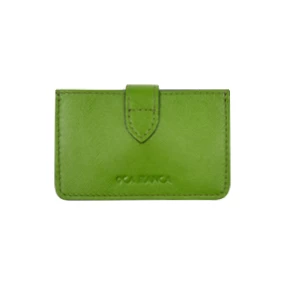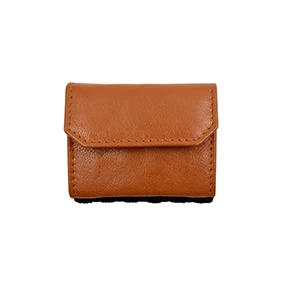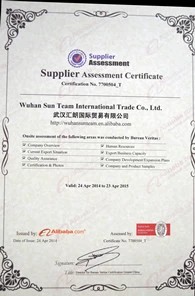How to Make a Leather Wallet(3)
Lily
www.walletwmazon.com
2017-07-12 10:30:56
The edge beveler takes off the corner edge and helps the appearance of rounding it. In general, these small touches go a long way to getting your leather work to look really nice – so it’s worth the effort.
Next I re-wet the grain side in preparation for stamping my logo and the unique maker number.
Before taking the piece out to dye and condition it, you need to punch the stitching holes. I have tried several methods and this is the one that is by far the easiest and quickest and least likely to draw blood. If you are interested – there are quite a few tutorials on how to hand-stitch and punch the holes at the same time, but I would recommend my method for now.
Follow the groove and punch across, make sure to fold the leather at the folds. After each punch, line up the last hole made with the first prong – this will ensure proper spacing.

Sometimes you need to fudge the end to make the last hole fit.
Be careful when you punch through with the folded leather – that you don’t let the punch cut the edge of the folded piece beneath. Basically creating a half-hole on the edge which looks like a tear.
Next you can optionally dye your leather. I like to use all-natural handmade dyes I make myself. In this case I am using walnut husks that have soaked in water. It helps to darken the leather a bit more.
If you dyed your leather, and even if you didn’t, you should make sure that piece is completely dry before moving on to the conditioning stage. If you don’t, and there’s a wet spot, that spot will not soak in the oil evenly and will make your piece look like a cow pie. To speed things up I use a heat gun, held at a distance or the leather will shrink.

Once completely dry, rub on some extra virgin olive oil onto the grain side (smooth side) only. When I was first starting out I oiled the flesh side as well and the result is that the piece will soak up way too much oil and get a bit soggy very quickly. With a couple of light coats on the grain side you should be fine. This helps give the leather some life, since the tanning process, wetting/casing, cutting, folding, dyeing …all takes the natural oils out of the leather. You will quickly see a nice change once the oil is applied – colors come to life and the leather will become more supple.
Next I usually add on a mixture of beeswax and walnut oil. This further conditions the leather, adds a bit of water resistance and makes things look even better.
The wax can be applied on both sides, and should be for that matter.
To smooth out the edges of the leather, slick them, and make them look well finished – I use a coco bolo leather burnisher made for the drill press. It is basically a shaped piece of smooth wood with grooves in it that you can push your leather up against while the drill press is on and it will slick and burnish everything. In my case I also taped on a cutting of old jeans. This helps quicken the process and does a better job…though I would recommend white canvas instead if you have it. Above I am applying a very small amount of water while the drill is on. Only a touch is necessary. If you don’t have access to one of these you can do it by hand as well. Just grab some canvas or jeans , very very lightly dampen them, then rub them against the edges very quickly. It will take a while, but you will get the same effect.
Next just hold your piece up to the burnisher with the drill press on and apply pressure. The pressure will create heat which helps to burnish the edges. At this point I only burnish the tops of the inner flaps. Later as a last step once everything is stitched up, I will burnish around all of the edges.

Next place your piece into the stitching pony like the above shot. If you don’t have one, it will be a bit tricky to stitch, but I have done it in the past! You can try using some clamps and pieces of wood too.
Tel:86 2785570058
Email:sunteam03@wuhansunteam.com
Website:www.leathergoods-manufacturers.com
Next I re-wet the grain side in preparation for stamping my logo and the unique maker number.
Before taking the piece out to dye and condition it, you need to punch the stitching holes. I have tried several methods and this is the one that is by far the easiest and quickest and least likely to draw blood. If you are interested – there are quite a few tutorials on how to hand-stitch and punch the holes at the same time, but I would recommend my method for now.
Follow the groove and punch across, make sure to fold the leather at the folds. After each punch, line up the last hole made with the first prong – this will ensure proper spacing.

Sometimes you need to fudge the end to make the last hole fit.
Be careful when you punch through with the folded leather – that you don’t let the punch cut the edge of the folded piece beneath. Basically creating a half-hole on the edge which looks like a tear.
Next you can optionally dye your leather. I like to use all-natural handmade dyes I make myself. In this case I am using walnut husks that have soaked in water. It helps to darken the leather a bit more.
If you dyed your leather, and even if you didn’t, you should make sure that piece is completely dry before moving on to the conditioning stage. If you don’t, and there’s a wet spot, that spot will not soak in the oil evenly and will make your piece look like a cow pie. To speed things up I use a heat gun, held at a distance or the leather will shrink.

Once completely dry, rub on some extra virgin olive oil onto the grain side (smooth side) only. When I was first starting out I oiled the flesh side as well and the result is that the piece will soak up way too much oil and get a bit soggy very quickly. With a couple of light coats on the grain side you should be fine. This helps give the leather some life, since the tanning process, wetting/casing, cutting, folding, dyeing …all takes the natural oils out of the leather. You will quickly see a nice change once the oil is applied – colors come to life and the leather will become more supple.
Next I usually add on a mixture of beeswax and walnut oil. This further conditions the leather, adds a bit of water resistance and makes things look even better.
The wax can be applied on both sides, and should be for that matter.
To smooth out the edges of the leather, slick them, and make them look well finished – I use a coco bolo leather burnisher made for the drill press. It is basically a shaped piece of smooth wood with grooves in it that you can push your leather up against while the drill press is on and it will slick and burnish everything. In my case I also taped on a cutting of old jeans. This helps quicken the process and does a better job…though I would recommend white canvas instead if you have it. Above I am applying a very small amount of water while the drill is on. Only a touch is necessary. If you don’t have access to one of these you can do it by hand as well. Just grab some canvas or jeans , very very lightly dampen them, then rub them against the edges very quickly. It will take a while, but you will get the same effect.
Next just hold your piece up to the burnisher with the drill press on and apply pressure. The pressure will create heat which helps to burnish the edges. At this point I only burnish the tops of the inner flaps. Later as a last step once everything is stitched up, I will burnish around all of the edges.

Next place your piece into the stitching pony like the above shot. If you don’t have one, it will be a bit tricky to stitch, but I have done it in the past! You can try using some clamps and pieces of wood too.
Tel:86 2785570058
Email:sunteam03@wuhansunteam.com
Website:www.leathergoods-manufacturers.com























